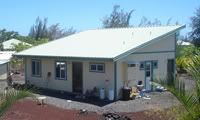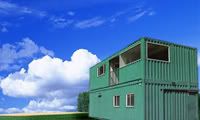Four objectives on energy efficiency should be achieved on a sustainable housing design :
1. It collects the sun’s heat that falls upon the building’s surfaces during the cold season;
2. It stores that heat so that it can be used during the night or during sunless days;
3. It distributes the stored heat throughout the house for comfort and energy efficiency;
4. It retains the heat in the building by reducing or eliminating usual sources of heat loss.
Ecological design to perform the above functions can be :
1. Active - relies on mechanical equipment (such as pumps, fans or photovoltaic cells) to collect and help transfer heat to storage;
2. Passive - relies on the parts of the building itself to perform the functions of heat collection, storage and distribution – often without mechanical means – thus considerably reducing cost and construction.
However, while heating may be an important aspect of sustainable house design in colder climates, in some climates, cooling may be just as important, if not more so.
A sustainable house should be designed in any climate to prevent overheating in summer, and there are numerous ways of accomplishing this, such as shading by trees or sun screens, ventilating the building interior, and orienting the building plan to cold breezes. Luckily, some equipment used for heating can also used for cooling, in ways that have largely been implemented in our house designs.
In temperate climates, from 20 to 50 percent of the annual heat for a home can be gained by heat from properly oriented and well-designed windows alone, with insulating controls.
An external greenhouse structure, such as a glassed-in porch or a sun room, is less expensive to build than a fully insulated structure, while also adding an additional area to the home that can be used as a garden (for growing vegetables), a socializing space around a pond, etc.).
In contrast to the passive approach, which relies on elements of building design and construction for natural control of climate, active systems use mechanical means (pumps, fans, automatic controls) to collect, store, and distribute heat and provide cooling to a home.
Local climate factors determine the amount of heating/cooling available, which in turn determines the appropriate equipment used to provide comfort for the house occupants.
In northern climates, for instance, fuel for domestic hot water requirements of a family of four, represent from 10% to 20% of the annual heating bill. The fuel savings that are possible with a solar domestic water heater can pay back the initial installation cost in such a climate, within a very few years.
In northern climates, heat from storage as low as 27C can provide comfort conditions. Usable heat could be stored for periods long enough to minimize backup heating needs, to the point that only a fireplace/stove or a small amount of electric heat would be the auxiliary heat required.
Passive, Active, or Both?
Yet, one should bear in mind that part of the task of creating comfort can be achieved without energy-consuming mechanical heating or cooling equipment, by responding to given climatic conditions in the design of the building shape, its orientation and materials, and that active systems are required only to take over during those periods when passive means are inadequate.
Furthermore, if passive means are first made part of the building construction, then solar collectors and any other mechanical heating or cooling equipment can be held to a size that is economically practical and does not “take over” the design of the house.














0 comments
Post a Comment